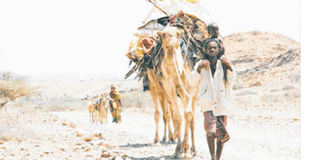Attempting to tackle drought with emergency aid is not the answer

For those forced to live through them, droughts are less an unusual event than a way of life that constantly tests your resilience and resourcefulness. PHOTO|IRIN
What you need to know:
- To be a farmer, or make a living from livestock in Ethiopia, where my organisation,Mercy Corps, has been working for many years, you need to be innovative in the face of ever-changing weather patterns.
- And yet the 2015 El Niño drought cycle – the worst in 50 years by some measures – tested even this population. One seasoned pastoralist reported recently to our staff that he’d “never seen anything like this drought”.
For those forced to live through them, droughts are less an unusual event than a way of life that constantly tests your resilience and resourcefulness.
To be a farmer, or make a living from livestock in Ethiopia, where my organisation,Mercy Corps, has been working for many years, you need to be innovative in the face of ever-changing weather patterns.
And yet the 2015 El Niño drought cycle – the worst in 50 years by some measures – tested even this population. One seasoned pastoralist reported recently to our staff that he’d “never seen anything like this drought”.
Though it has driven an estimated 10 million people into food insecurity, the drought was not particularly surprising – weather-related crises have increased in frequency in this part of the world over the last decade.
Facing these extreme climate patterns, many development organisations have recognised what former USAID Administrator Rajiv Shah stated: that “segregated humanitarian support activities and development activities” no longer work in these contexts.
What is needed are carefully sequenced, layered, and integrated interventions that work together to build household and community capacity to learn, cope, adapt, and transform in the face of shocks and stresses, rather than a reliance on costly direct emergency assistance after the fact.
To this end, instead of the traditional humanitarian assistance method of direct delivery of resources like food, medicine, or other equipment, Mercy Corps has adopted a new approach designed with resilience as a central feature. Our aim is to ensure that wellbeing like food security, economic status, and health are maintained or improved despite recurrent shocks.
Putting this into practice requires longer-term strategies that take into account the many factors that influence resilience and vulnerability at different levels of society – from household to community to region.
One example of our resilience-building is the USAID-funded Pastoralist Areas Resilience Improvement through Market Expansion project in Ethiopia, which relies largely on strengthening the market systems in which households participate. The PRIME programme does this in part through strategic subsidies aimed at supporting individuals and local businesses to expand their livelihood options – including support to develop and adopt new technologies, skills training, and improved access to natural resources.
Simultaneously, linkages are created between producers and consumers, potential employers and employees, suppliers and retailers, and communities and government institutions. By then providing support through ongoing research, demonstration, and training, these individuals and communities are given the help they need to access the global market and to sustain their gains.
This kind of resilience-focused programming sounds like a good idea – but does it actually work? Until recently, little evidence existed to address this question. But new Mercy Corps research offers some promising observations about the effectiveness of a resilience approach.
While such work has been evaluated before, no one to our knowledge has rigorously evaluated a programme‘s impact in real time in the context of a major shock. By conducting this study during a major drought cycle, we were able to leverage a rare opportunity.
The writer filed this article for IRIN from San Francisco


